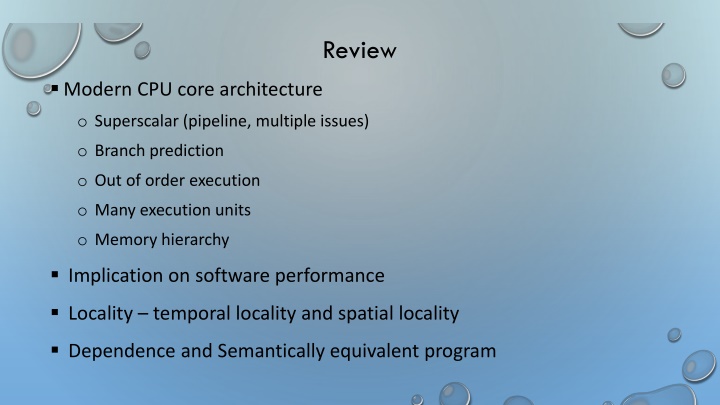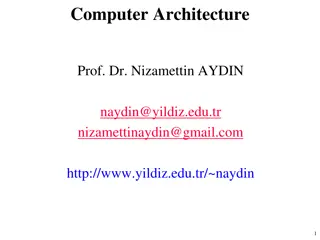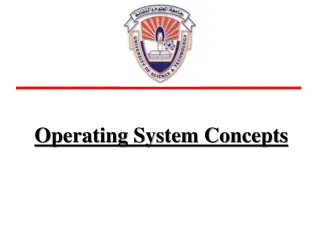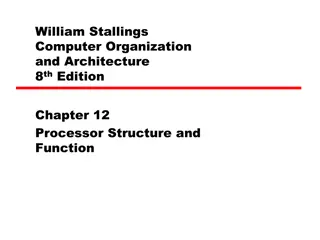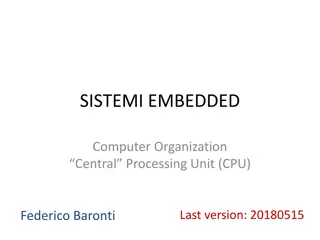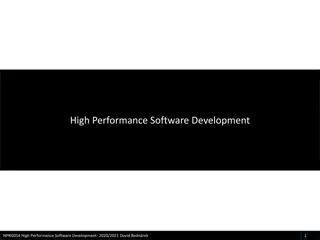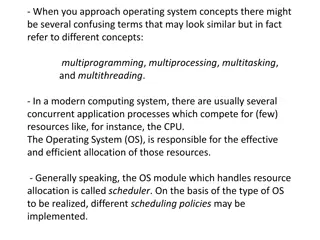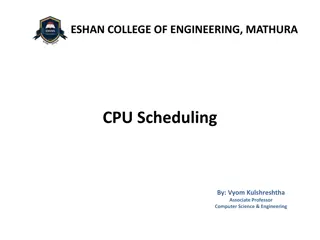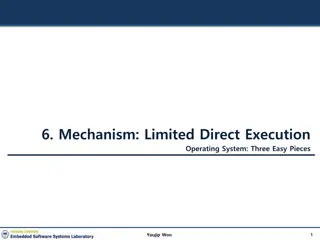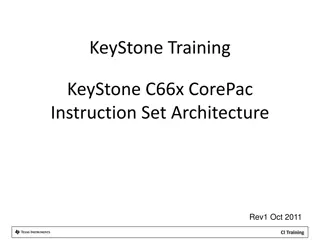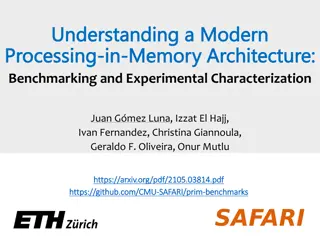Modern CPU Core Architecture Implications on Software Performance
Delve into the intricacies of modern CPU core architecture, including superscalar design, branch prediction, out-of-order execution, memory hierarchy, and their impact on software performance. Explore concepts like data dependence, loop optimizations, affine expressions, and affine loops.
Download Presentation

Please find below an Image/Link to download the presentation.
The content on the website is provided AS IS for your information and personal use only. It may not be sold, licensed, or shared on other websites without obtaining consent from the author.If you encounter any issues during the download, it is possible that the publisher has removed the file from their server.
You are allowed to download the files provided on this website for personal or commercial use, subject to the condition that they are used lawfully. All files are the property of their respective owners.
The content on the website is provided AS IS for your information and personal use only. It may not be sold, licensed, or shared on other websites without obtaining consent from the author.
E N D
Presentation Transcript
Review Modern CPU core architecture o Superscalar (pipeline, multiple issues) o Branch prediction o Out of order execution o Many execution units o Memory hierarchy Implication on software performance Locality temporal locality and spatial locality Dependence and Semantically equivalent program
Dependence Two instructions (tasks) have dependence when they operate on the same data with at least one operation being write. The order of two instructions can be swapped when they do not have dependence. Three types of data dependence: True dependence: Write X-Read X (RAW) Output dependence: Write X Write X (WAW) Anti dependence: Read X Write X (WAR) What about RAR?
Loop optimizations making higher performance loops Why loops? o Most of the program time is spent on loops. o Most parallelism in a program is inside loops. Focusing on affine loops only with affine array accesses. o Non affine loops are much harder to analyze and manipulate. for (i =0; i<n; i++) for (j=0; j<n; j++) m[i][j] = 0; An example affine loop
Affine expression and affine array accesses Let ?1, ?2, , ?? be a set of variables. An affine expression is a linear expression of the variables: ????+ ?? 1?? 1+ + ?1?1+ ?0 Here, ??, ?? 1, , ??are constants. Affine array accesses: array indexes are affine expressions of loop indices o Let ?1, ?2, , ?? be loop index variables. Array indexes are affine expressions of the loop index variables ????+ ?? 1?? 1+ + ?1?1+ ?0 Here, ??, ?? 1, , ??are integer constants. o Cover common array access patterns: a[i], a[j], a[i+1], a[i+j], a[2*i], etc. o No a[b[j]] or a[i*i] -- No good static techniques for loops with such array references (irregular problems).
Affine loops All loop bounds have to be affine expressions of the loop index variables of the containing loops. All array references are affine array accesses. No pointers, no aliases of the arrays. for (i=0; i<n; i++) for (j=0; j<n; j++) a[i+j*10] = 0; for (i=0; i<n; i++) for (j=0; j<n; j++) a[i][j+1] = 0; for (i=0; i<n; i++) for (j=0; j<n; j++) a[i*j] = 0; for (i=0; i<n; i++) for (j=0; j<n; j++) a[b[i][j]] = 0;
Affine loops Each loop has three components: a lower bound L, an upper bound U, and a step S. for (int i = L, i < U; i+=S) { // loop body } All loop bounds are affine expressions of the loop index variables of the containing loops. For a nest of n loops, the iteration of the innermost loop can be represented by an iteration vector ? = ?1,?2, ,??, where n is the innermost loop.
Iteration Number and Vector for an n-level loop: ? = ?1,?2, ,?? for (int ?1= ?1; ?1<?1; ?1+= ?1) { for (int ?2= ?2; ?2<?2; ?2+= ?2) { for (int ??= ??; ??<??; ??+= ??) { // innermost loop body } } }
Iteration Number and Vector If the statements in iteration ? = ?1,?2, ,?? are executed before the statements in iteration ? = ?1,?2, ,??, we say ? < ?. To compare ?= ?1,?2, ,?? and ? = ?1,?2, ,?? o if ?1< ?1, then ? < ? o if ?1< ?1, then ? < ? o if ?1= ?1, then recursively compare ?2, ,?? and ?2, ,?? Example: o compare ? = [10] and ? = [20] o compare ? = [4, 10] and ? = [0, 20] o compare ? = [10, 30, 20] and ? = [10, 20, 30]
Dependence in the loop and loop parallelism for (i=0; i<n; i++) c[i] = a[i] + b[i]; For some loops like the one above, executing loop iterations in any order yields the same results (semantically equivalent). o Different iterations access different data (no dependence across iterations) This type of loops is said to be parallelizable. One can execute the loop on n processors by giving each processor an ID = 0, 1, , n-1. Each processor executes the same code c[ID] = a[ID] + b[ID].
Dependence in a loop for (i=1; i<n; i++) a[i] = a[i-1] + b[i]; For some loops like the one above, executing loop iterations in different order will yield different results. o Iteration [1]: a[1] = a[0] + b[1] o Iteration [2]: a[2] = a[1] + b[2] o Iteration [3]: a[3] = a[2] + b[3] There is a true dependence across loop iterations. The iterations must be executed in the original order.
Dependence in a loop for (i=1; i<n; i++) S: a[i] = a[i-1] + b[i]; Statement S1 in iteration vector ? and S2 in iteration ? have dependence when 1. S1 in iteration ? and S2 in iteration ? access a common memory location. 2. One of the access is a write. In the above code example, statement S in iteration ? =[i] write to a[i] and in iteration ? = i + 1 read from a[i]. Thus, statement S in iteration vector ? = [?] and S in iteration ? = [? + 1] have dependence.
Loop carried dependence A loop-carried dependence is a dependence that is present only when the dependence is between statements in different iterations of a loop. Otherwise, we call it loop-independent dependence. Loop-carried dependence must be preserved when we restructure the loop (change the order in the iteration space). Loop-carried dependence is also what prevents loops from being parallelized.
Data dependence analysis Data dependence analysis (by the compiler or human) is to compute the set of statement instances that are dependent. This is an important step for the compiler (or human) to restructure or parallelize the loops. How is this done? Check every pair of memory references to see if there is a dependence due to the memory references. The dependence is often represented as dependence distance vectors or dependence direction vectors. for (i=1; i<n; i++) c[i] = a[i] + b[i]; for (i=10; i<n; i++) a[i] = a[i-1] + b[i]; for (i=10; i<n; i++) a[i] = a[i-10] + b[i];
Distance vector and direction vector Let S1 in iteration ? and S2 on iteration ? be two statements. Let there be dependence between the two statements. The dependence distance ? of length n is defined as: ? ?, ?= ? ? Let ? be a vector, ?(k) be the kth item of the vector, then ? ?, ?(?) = ?(?) ?(k)
Distance vector and direction vector Let ? ?, ? be the direction vector "<", ? ?, ?? > 0 "=", ? ?, ?? = 0 " > ", ? ?, ?? < 0 ? ?, ?(?) =
Distance vector and direction vector example for (int i = 0; i<n; i++) for (int j=0; j<n; j++) for (int k=0; k<n; k++) { S1: a[i+1][j][k-2] = a[i][j][k] + 1; S2: a[i+1][j-1][k+2] = c[i][j][k] + d[i][j][k]; } Get each pair of array references for potential dependence Five array references in the loop. Arrays c and d are used only once no dependence. Array a is used three times. We need to analyze the dependence between three pairs in the program: a[i+1][j][k-2] and a[i][j][k], a[i+1][j][k-2] and a[i+1][j-1][k+2], and a[i+1][j- 1][k+2] and a[i][j][k]. Each pair results in a distance vector (or direction vector).
Distance vector and direction vector example a[i+1][j][k-2] and a[i][j][k]: oa[?1+1][?1][?1-2] and a[?2][?2][?2] is the same memory ?1+1=?2, ?1=?2, and ?1-2 = ?2 oHence, distance vector ? = ? ? = [?2, ?2, ?2] [?1, ?1, ?1] = [?2 ?1, ?2 ?1, ?2 ?1] = [1, 0, -2]. o Direction vector = [<, =, >]. a[i+1][j][k-2] and a[i+1][j-1][k+2]? a[i+1][j-1][k+2] and a[i][j][k]?
Summary Affine array accesses and affine loops How to compute dependence vector and direction vector.
